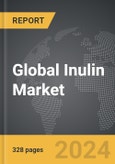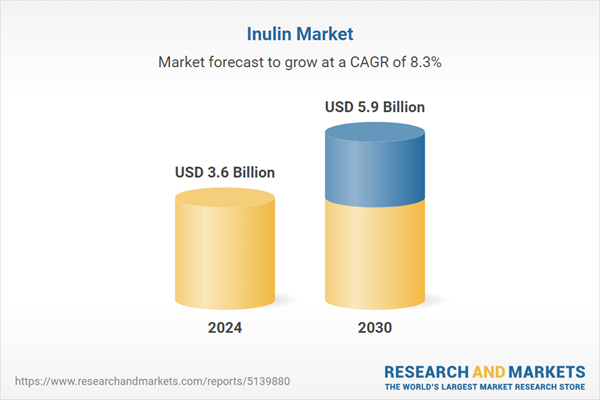The global market for Inulin was valued at US$3.6 Billion in 2024 and is projected to reach US$5.9 Billion by 2030, growing at a CAGR of 8.3% from 2024 to 2030. This comprehensive report provides an in-depth analysis of market trends, drivers, and forecasts, helping you make informed business decisions. The report includes the most recent global tariff developments and how they impact the Inulin market.
Segments: Application (Food & Beverage, Dietary Supplements, Pharmaceuticals, Other Applications).
Geographic Regions/Countries: World; United States; Canada; Japan; China; Europe (France; Germany; Italy; United Kingdom; Spain; Russia; and Rest of Europe); Asia-Pacific (Australia; India; South Korea; and Rest of Asia-Pacific); Latin America (Argentina; Brazil; Mexico; and Rest of Latin America); Middle East (Iran; Israel; Saudi Arabia; United Arab Emirates; and Rest of Middle East); and Africa.
The analysts continuously track trade developments worldwide, drawing insights from leading global economists and over 200 industry and policy institutions, including think tanks, trade organizations, and national economic advisory bodies. This intelligence is integrated into forecasting models to provide timely, data-driven analysis of emerging risks and opportunities.
Global Inulin Market - Key Trends & Drivers Summarized
What Is Inulin and How Is It Transforming Health and Nutrition?
Inulin is a type of soluble fiber found naturally in many plants, but it is most commonly extracted from chicory root. As a fructan, it consists of fructose molecules linked together in a way that the human digestive system cannot break down, which makes it function as a prebiotic. Prebiotics are essential as they stimulate the growth of beneficial bacteria in the gut, which plays a crucial role in digestion, absorption of nutrients, and overall health. Inulin's popularity in the food and beverage industry is rising due to its versatility. It can be used to replace sugar, fat, and flour in products, which is particularly appealing in the creation of low-calorie, low-fat, and gluten-free options. Moreover, inulin's health benefits, such as improving digestive health, enhancing calcium absorption, and potentially aiding in weight management, make it an ingredient of choice for health-conscious consumers.How Is Consumer Demand Shaping the Inulin Market?
The shift in consumer preferences towards healthier and more natural food ingredients has significantly boosted the demand for inulin. In today’s health-conscious world, consumers are increasingly aware of the ingredients in their food and the impact on their health. This awareness is driven by the rising prevalence of health issues such as obesity, diabetes, and digestive problems. Inulin not only appeals to the health aspect but also aligns with the growing trends for plant-based and clean-label products. Food manufacturers are tapping into this demand by incorporating inulin into a variety of products, including bakery goods, dairy products, functional beverages, and dietary supplements, to enhance their fiber content and texture while maintaining a pleasing taste.What Technological Innovations Impact Inulin Production and Application?
Technological advancements have played a pivotal role in the extraction and incorporation of inulin into various products. Improved extraction techniques have enabled producers to obtain higher yields and purity of inulin from natural sources, primarily chicory roots. Furthermore, advancements in food technology have facilitated the development of new applications for inulin. For instance, microencapsulation technology allows inulin to be used as a fat replacer in yogurts and ice creams, maintaining texture and flavor while reducing the caloric content. These innovations not only improve the functionality of inulin as an ingredient but also enhance its appeal to food manufacturers looking for cost-effective ways to improve the health profile of their products.What Are the Growth Drivers in the Inulin Market?
The growth in the inulin market is driven by several factors, focusing on consumer trends, technological advancements, and the broadening applications of inulin. The increasing global focus on health and wellness is a major driver, as consumers seek out dietary fibers that support digestive health and weight management. The rise in popularity of functional foods that cater to specific dietary needs, such as gluten intolerance and calorie reduction, also significantly contributes to this growth. Additionally, technological innovations in food processing and ingredient formulation have expanded inulin's applications across a wider range of products. Lastly, the growing vegan and plant-based movement has fueled the demand for naturally sourced ingredients like inulin, cementing its position in the market as a versatile and beneficial ingredient. These factors collectively sustain and accelerate the expansion of the inulin market, reflecting its increasing importance in the global food industry.Report Scope
The report analyzes the Inulin market, presented in terms of units. The analysis covers the key segments and geographic regions outlined below.Segments: Application (Food & Beverage, Dietary Supplements, Pharmaceuticals, Other Applications).
Geographic Regions/Countries: World; United States; Canada; Japan; China; Europe (France; Germany; Italy; United Kingdom; Spain; Russia; and Rest of Europe); Asia-Pacific (Australia; India; South Korea; and Rest of Asia-Pacific); Latin America (Argentina; Brazil; Mexico; and Rest of Latin America); Middle East (Iran; Israel; Saudi Arabia; United Arab Emirates; and Rest of Middle East); and Africa.
Key Insights:
- Market Growth: Understand the significant growth trajectory of the Food & Beverage segment, which is expected to reach US$3.2 Billion by 2030 with a CAGR of a 8.1%. The Dietary Supplements segment is also set to grow at 9.2% CAGR over the analysis period.
- Regional Analysis: Gain insights into the U.S. market, valued at $932.6 Million in 2024, and China, forecasted to grow at an impressive 12.2% CAGR to reach $1.5 Billion by 2030. Discover growth trends in other key regions, including Japan, Canada, Germany, and the Asia-Pacific.
Why You Should Buy This Report:
- Detailed Market Analysis: Access a thorough analysis of the Global Inulin Market, covering all major geographic regions and market segments.
- Competitive Insights: Get an overview of the competitive landscape, including the market presence of major players across different geographies.
- Future Trends and Drivers: Understand the key trends and drivers shaping the future of the Global Inulin Market.
- Actionable Insights: Benefit from actionable insights that can help you identify new revenue opportunities and make strategic business decisions.
Key Questions Answered:
- How is the Global Inulin Market expected to evolve by 2030?
- What are the main drivers and restraints affecting the market?
- Which market segments will grow the most over the forecast period?
- How will market shares for different regions and segments change by 2030?
- Who are the leading players in the market, and what are their prospects?
Report Features:
- Comprehensive Market Data: Independent analysis of annual sales and market forecasts in US$ Million from 2024 to 2030.
- In-Depth Regional Analysis: Detailed insights into key markets, including the U.S., China, Japan, Canada, Europe, Asia-Pacific, Latin America, Middle East, and Africa.
- Company Profiles: Coverage of players such as Cargill, Inc., Ciranda, Inc., Cosucra Groupe Warcoing SA, Royal Cosun, Sudzucker AG and more.
- Complimentary Updates: Receive free report updates for one year to keep you informed of the latest market developments.
Some of the 52 companies featured in this Inulin market report include:
- Cargill, Inc.
- Ciranda, Inc.
- Cosucra Groupe Warcoing SA
- Royal Cosun
- Sudzucker AG
- The Green Labs LLC.
Tariff Impact Analysis: Key Insights for 2025
Global tariff negotiations across 180+ countries are reshaping supply chains, costs, and competitiveness. This report reflects the latest developments as of April 2025 and incorporates forward-looking insights into the market outlook.The analysts continuously track trade developments worldwide, drawing insights from leading global economists and over 200 industry and policy institutions, including think tanks, trade organizations, and national economic advisory bodies. This intelligence is integrated into forecasting models to provide timely, data-driven analysis of emerging risks and opportunities.
What’s Included in This Edition:
- Tariff-adjusted market forecasts by region and segment
- Analysis of cost and supply chain implications by sourcing and trade exposure
- Strategic insights into geographic shifts
Buyers receive a free July 2025 update with:
- Finalized tariff impacts and new trade agreement effects
- Updated projections reflecting global sourcing and cost shifts
- Expanded country-specific coverage across the industry
Table of Contents
I. METHODOLOGYII. EXECUTIVE SUMMARY2. FOCUS ON SELECT PLAYERSIII. MARKET ANALYSISSOUTH KOREAREST OF ASIA-PACIFICARGENTINABRAZILMEXICOREST OF LATIN AMERICAIRANISRAELSAUDI ARABIAUNITED ARAB EMIRATESREST OF MIDDLE EASTIV. COMPETITION
1. MARKET OVERVIEW
3. MARKET TRENDS & DRIVERS
4. GLOBAL MARKET PERSPECTIVE
UNITED STATES
CANADA
JAPAN
CHINA
EUROPE
FRANCE
GERMANY
ITALY
UNITED KINGDOM
SPAIN
RUSSIA
REST OF EUROPE
ASIA-PACIFIC
AUSTRALIA
INDIA
LATIN AMERICA
MIDDLE EAST
AFRICA
Companies Mentioned (Partial List)
A selection of companies mentioned in this report includes, but is not limited to:
- Cargill, Inc.
- Ciranda, Inc.
- Cosucra Groupe Warcoing SA
- Royal Cosun
- Sudzucker AG
- The Green Labs LLC.
Table Information
| Report Attribute | Details |
|---|---|
| No. of Pages | 328 |
| Published | April 2025 |
| Forecast Period | 2024 - 2030 |
| Estimated Market Value ( USD | $ 3.6 Billion |
| Forecasted Market Value ( USD | $ 5.9 Billion |
| Compound Annual Growth Rate | 8.3% |
| Regions Covered | Global |









